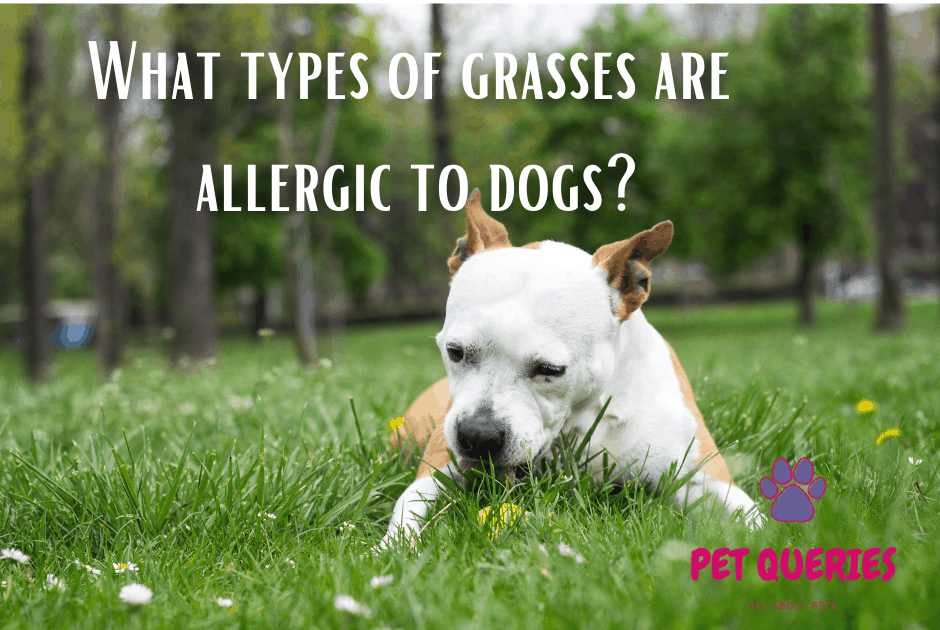
It is very common for dogs to get allergies. Several types of allergies are common in dogs. Like humans, the pollen grains found on grasses are the main reason for allergies in dogs.
The same pollen that causes allergy in humans is the reason for allergies in dogs as well. But the symptoms may vary and differ in dogs.
Here in this guide, today we will discuss the types of grasses which are allergic to dogs, the symptoms of allergies in dogs, and how to treat the grass allergies in dogs.
Table of Contents
What are the types of grasses that are allergic to dogs?
The pollen grains from the grasses like Bermuda cause allergies in dogs. The flower top of the grasses contains pollen grains. These pollen grains, when coming in contact with dogs, cause allergies in them.
Also, it is common practice to cut the grasses before the development of flower heads. The microscopic pollen grains on the underdeveloped flower heads float through the air and cause allergies in dogs and humans as well.
The Bermuda grasses and other similar grasses also have a habit of releasing their pollen in the air and thus cause more allergies in dogs.
Foxatails are another type of grasses having sharply pointed seed heads. Since the seedy heads in this grass are pointy so get easily picked up by the pup’s coat while walking through the grass. Once attached to the pup’s coat, these seeds go deeper into the body/ skin and cause discomfort, tremendous pain, and sometimes severe infection in dogs.
The Foaxatails are defamed grass, having the potential to cause an abscess in dogs. They are known to cause infection in ear canals and cause the formation of abscesses there. Sometimes through the ear canal may go deep and cause infection in the internal organs as well.
In the plants like Bottlebrush, the pollens are tiny in size and have a sharp structure. These sharp sticky pollens may get attached to the coat of the fury baby and cause reactions like sneezing, itching, and coughing.
What are the symptoms of allergies in dogs?
Since the allergens in dogs are the same as in humans, so the symptoms in canine buddy are almost similar as in humans. But sometimes, the symptoms may vary. The symptoms basically depend on the type of allergens. Here we are discussing the basic symptoms that are commonly seen in dogs after allergies:
Mild symptoms
- Itching in the back and the base of the tail
- Itching ears and sometimes may lead to the infection in the ears
- Increased scratching
- Sneezing
- Itchy, runny eyes
Moderate symptoms
- More itchiness, redness, moist and scabbed skin
- Snoring due to inflamed throat
- Paw chewing/ swollen paws
- Vomiting – more common on the consuming of allergy-causing grasses
- Constant licking
- Diarrhea – more common on the consuming of allergy-causing grasses
- More chances of fungal infection also.
Severe symptoms
- In severe cases, there will be more prominent symptoms, as mentioned in the moderate allergies.
- There may be difficulty in breathing and Asthma
- Infection is often the sequel of severe allergies
- The chances of fungal infection increases in severe allergies
How to treat allergies in dogs?
The most common treatment used by veterinarians for allergies in dogs includes the use of antihistamines, corticosteroids, and the use of topical ointments like cortisone cream or gel.
Your vet may prescribe some medicinal shampoo to decrease the itchiness and inflammation in dogs.
Serum therapy is another approach used by animal doctors to treat allergies in dogs. In this case, the blood from the victim dog is collected; serum is extracted from the blood and injected back into the victim dog intramuscularly. This treatment might take time but will respond for sure.
Precautions
In order to prevent or reduce allergies in dogs, go for the hybrid grasses as they have less chance to cause allergies.
Also, if you know that your dog is allergic to a certain type of grass, avoid taking your canine buddy near to that grass area.
The bottom line
So this was a complete guide on the type of grasses that cause allergy in dogs, the symptoms of allergies in dogs, how to treat them, and what precautions a dog owner should adopt to protect their four-legged best friend from the grass allergy.
